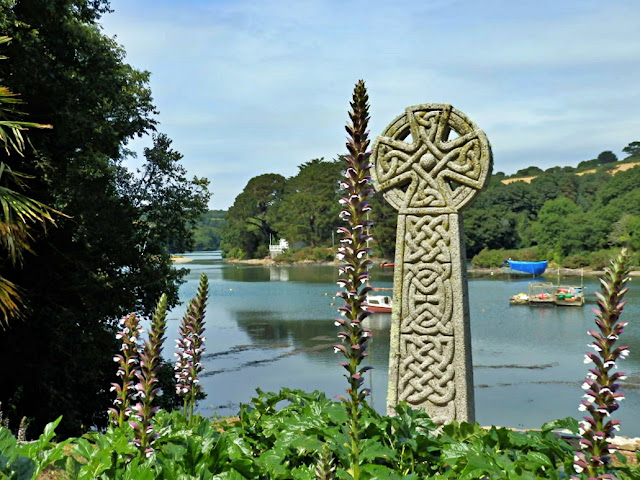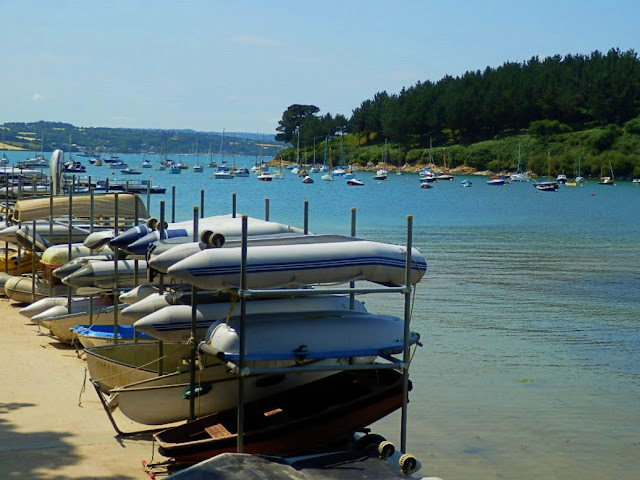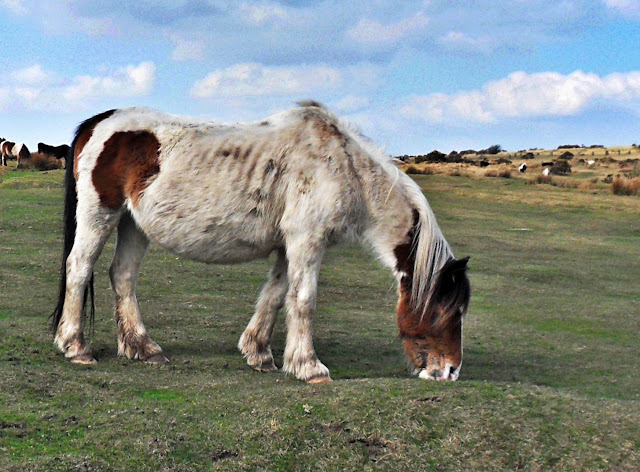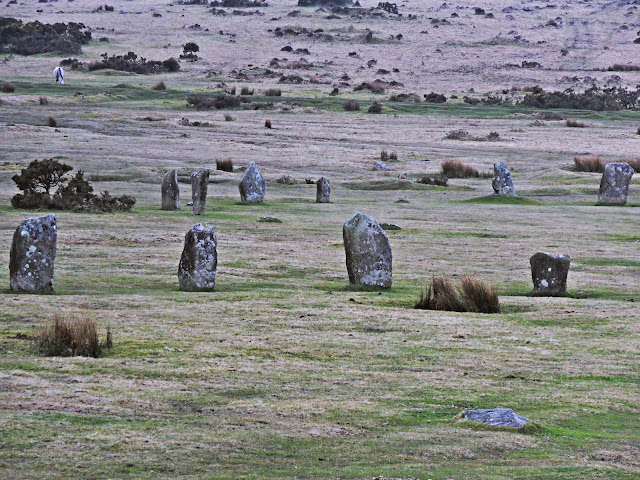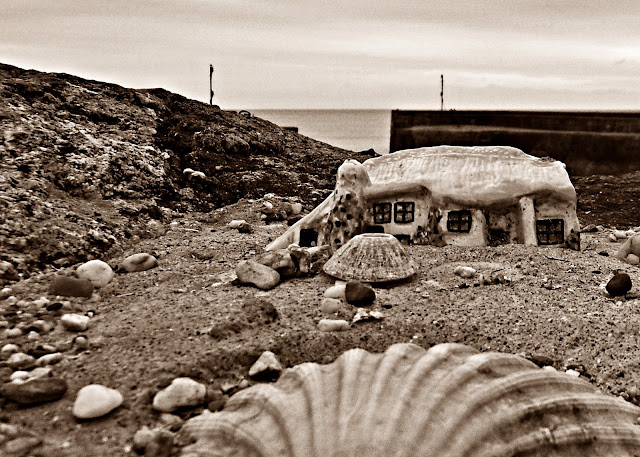Sunday 7 April 2019
Is St Just-in-Roseland The Most Beautiful Churchyard On Earth?
Yes, it's still Cornwall! This is St. Just-in-Roseland, with it's 13th century church and is one of my favourite places to visit - so very peaceful. Somehow there is a special feeling within the sub tropical churchyard and gardens set beside the river's creek.
The photos were taken on a sunny day last year.
Sir John Betjeman suggested that this is perhaps the most beautiful churchyard on earth.
When you look down from on high - as per the photo below - the church is in an idyllic position.
The river almost embraces the church when the tide is high.
The graves and memorials in the churchyard are beautifully maintained:
The church itself is very simple inside. When we visited there was a group of people making wicker baskets, and it gives the impression of being a much loved place.
Oh yes, and as a bonus, there is also a Holy Well in the church grounds - as photo below. Unfortunately it didn't look it's best as the banks had been cut. Nevertheless I dabbed a little of the water on my face - you never know the power of a Holy Well!
After viewing the church and grounds it's possible to continue walking along the river to St Mawes Castle. Perfect!
See Also:
Did Jesus Visit Cornwall?
Friday 5 April 2019
Fisherman's Friends Trailer
We went to see the Fisherman's Friends film on Wednesday. Tells the story of the how ten fishermen from Port Isaac, Cornwall are signed by Universal Records and achieve a top ten hit with their debut album of Sea Shanties.
A true story and it's a feel good film with a message about what is really important in life. I enjoyed it and the Cornish scenery of Port Isaac was, of course, wonderful.
The trailer gives a flavour of the film.
Port Isaac is also the stomping ground of television's Doc Martin - where Port Isaac becomes Portwenn.
Bodmin Jail and a Hanging Watched by 25,000 People
A different sort of post today copied from one of my old blogs. It features Bodmin Jail, a dream precogniton and a hanging watched by nearly 25,000 people. The photos are of Bodmin Jail. Here we go:
Captain Edmund Norway, the master of the merchant ship Orient, was situated seven miles off the volcanic island of St. Helena in the south Atlantic.
On the 8th of February 1840 the Captain awoke with a start. He had been dreaming and told his second officer, Mr Wren, what he had dreamt:
Seeing his Captain was unsettled by this Mr Wren told him, "Don’t worry about it. You west country people are too superstitious." Captain Norway was from Cornwall, England.
But it must have concerned the Captain as on February 9th, 1840 he took the trouble to record his dream, and the conversation with Wren, in the ship's log.
Nevill Norway, a highly respectable timber and general merchant, was killed exactly as his brother had recorded and the murder caused considerable interest and discussion in Bodmin, Cornwall and the surrounding area. So much so that a police officer from London was sent to help with the enquiries.
Nevill had been seen on the day of the murder at Bodmin market and was carrying a considerable amount of money. It is thought he was seen by brothers, William and James Lightfoot, who were later arrested for Nevill Norway's murder. They each initially blamed the other brother.
William Lightfoot finally gave his version of what had happened:
William and James Lightfoot were found guilty at the court and Monday, the 13th of April, 1840 was fixed for their execution by hanging at Bodmin Jail.
The hanging became cause for almost a party atmosphere and 20-25,000 people went to watch the double hanging. This is how the local newspaper, The West Briton, reported the execution:
Bodmin Jail was built back in the reign of George III in 1777. Prisoners helped - though not necessarily willingly - to transport 20,000 tons of granite from Bodmin's Cuckoo Quarry for its erection.
Captain Edmund Norway, the master of the merchant ship Orient, was situated seven miles off the volcanic island of St. Helena in the south Atlantic.
On the 8th of February 1840 the Captain awoke with a start. He had been dreaming and told his second officer, Mr Wren, what he had dreamt:
"I had a dreadful dream. I dreamt that my brother Nevill was murdered by two men on the road from Bodmin to Wadebridge (Cornwall). One fired a pistol twice, but I heard no report. He then knocked my brother from his horse, struck him several blows about the head, then ran away and left him."
Seeing his Captain was unsettled by this Mr Wren told him, "Don’t worry about it. You west country people are too superstitious." Captain Norway was from Cornwall, England.
But it must have concerned the Captain as on February 9th, 1840 he took the trouble to record his dream, and the conversation with Wren, in the ship's log.
Nevill Norway, a highly respectable timber and general merchant, was killed exactly as his brother had recorded and the murder caused considerable interest and discussion in Bodmin, Cornwall and the surrounding area. So much so that a police officer from London was sent to help with the enquiries.
Nevill had been seen on the day of the murder at Bodmin market and was carrying a considerable amount of money. It is thought he was seen by brothers, William and James Lightfoot, who were later arrested for Nevill Norway's murder. They each initially blamed the other brother.
William Lightfoot finally gave his version of what had happened:
"He and his brother had met by appointment, and were determined to have some money; that is when Mr Norway came up, James snapped his pistol at him twice; that he (William) then gave him a blow with a stick; so he fell off his horse, and that James struck him with his pistol."
William and James Lightfoot were found guilty at the court and Monday, the 13th of April, 1840 was fixed for their execution by hanging at Bodmin Jail.
The hanging became cause for almost a party atmosphere and 20-25,000 people went to watch the double hanging. This is how the local newspaper, The West Briton, reported the execution:
"The execution of these wretched men (William and James Lightfoot) who murdered Nevill Norway, took place on Monday last, in front of the County Gaol.
The town of Bodmin on the Sunday evening presented the appearance of a fair, every Public House and as many private houses were filled to overflowing.
On Monday morning the road up to the prison was barricaded off from the public leaving a large open space below the drop which was occupied by the Sheriff's Javelin men and the local and special Constables.
People began to assemble very early in the morning and by twelve o'clock, the hour of execution, there could have been no less than from twenty to twenty-five thousand persons.
The prisoners were launched into eternity. They died almost immediately. The shoe of William, through the jerk, fell off.
After hanging for an hour, the bodies were cut down and put into a couple of black coffins. They were buried in a hole about three feet in the coal yard just in front of the prison.
~ West Briton Newspaper 17th April 1840.
The town of Bodmin on the Sunday evening presented the appearance of a fair, every Public House and as many private houses were filled to overflowing.
On Monday morning the road up to the prison was barricaded off from the public leaving a large open space below the drop which was occupied by the Sheriff's Javelin men and the local and special Constables.
People began to assemble very early in the morning and by twelve o'clock, the hour of execution, there could have been no less than from twenty to twenty-five thousand persons.
The prisoners were launched into eternity. They died almost immediately. The shoe of William, through the jerk, fell off.
After hanging for an hour, the bodies were cut down and put into a couple of black coffins. They were buried in a hole about three feet in the coal yard just in front of the prison.
~ West Briton Newspaper 17th April 1840.
The Lightfoot brothers are said to still haunt Bodmin Jail.
Bodmin Jail was built back in the reign of George III in 1777. Prisoners helped - though not necessarily willingly - to transport 20,000 tons of granite from Bodmin's Cuckoo Quarry for its erection.
Thursday 4 April 2019
The Ancient Stone, Over 1100 Years Old, Known As King Doniert's Stone
The stones in the photos may not look that exciting but I guess we wouldn't either if we were at least 1100 years old. They are known as King Doniert's Stone or Men Myghtern Doniert in the Cornish language.
We visited them on the same day as the Hurlers Stone Circles on Bodmin Moor - as per my last two posts.
The stones are recent compared to the Hurlers. They only date back to the 9th Century whereas the Hurlers Stone Circles go way back to around 3000 BC.
It is believed the two granite stones are actually bases for Celtic Crosses. Each stone has a rectangular socket in the top, which would have held a wooden cross.
The shortest stone carries a Latin inscription: 'Doniert Progavit Pro Anima' which translates as 'Doniert ordered (this cross) for (the good of) his soul'.
Doniert (or Dungarth) was probably a King of Cornwall who drowned in the year 875.
In the the 17th century local miners, prospecting close to the crosses, broke into an underground chamber beneath the stones. Since then there have been various theories suggesting that the chamber might represent a chapel or vault associated with the stones. Or there again they could be simply remnants of the old mining industry. As with lots of ancient things in Cornwall there is often a mystery attached to them.
The stones are near St.Cleer, about three miles north of Liskeard, by the side of a narrow road which leads to Bodmin Moor and the Hurlers Stone Circles.
We visited them on the same day as the Hurlers Stone Circles on Bodmin Moor - as per my last two posts.
The stones are recent compared to the Hurlers. They only date back to the 9th Century whereas the Hurlers Stone Circles go way back to around 3000 BC.
It is believed the two granite stones are actually bases for Celtic Crosses. Each stone has a rectangular socket in the top, which would have held a wooden cross.
The shortest stone carries a Latin inscription: 'Doniert Progavit Pro Anima' which translates as 'Doniert ordered (this cross) for (the good of) his soul'.
Doniert (or Dungarth) was probably a King of Cornwall who drowned in the year 875.
In the the 17th century local miners, prospecting close to the crosses, broke into an underground chamber beneath the stones. Since then there have been various theories suggesting that the chamber might represent a chapel or vault associated with the stones. Or there again they could be simply remnants of the old mining industry. As with lots of ancient things in Cornwall there is often a mystery attached to them.
The stones are near St.Cleer, about three miles north of Liskeard, by the side of a narrow road which leads to Bodmin Moor and the Hurlers Stone Circles.
Wednesday 3 April 2019
Dando and His Dogs Hunting For Human Souls On Bodmin Moor
Following on from yesterday's post - we were walking on the mystical Bodmin Moor in Cornwall, England where there are wild ponies and other animals grazing the moorland.
It's good to see animals roaming free as they have done for thousands of years. The ponies happily posed for my photos.
As the wind blows across the wide expanse of moorland it's easy to imagine the legends of the moor coming to life. Dando and His Dogs could well be nearby hunting for human souls.
Fluffy, beautiful ponies are one thing, but Dando is something not to be messed with.
Hearing Dando's baying hounds echoing over the moor is enough to make even the bravest fear for their lives. If the dogs are heard it's best to move on quickly before the hunter catches sight of your soul. One poor fellow lingered until it was nearly too late, but fortunately he remembered what he had to do to escape. Others aren't so lucky or as well informed.
Dando the hunter is evil with big saucer like eyes, horns from his head and a tail blowing in the wind, he is the devil himself. With his hunting pole at the ready his dogs snort out fire, scorching the moorland surface as they snarl and snap at any unfortunate human.
The man I mentioned remembered the advice his father had given him as a child about Dando and his Dogs. The only way to escape is to surrender yourself to God and pray.
The man dropped to his knees and prayed and the dogs fell silent. Dando called for them to move on in pursuit of another soul - one who may not be aware of the secret knowledge to save him or her from evil.
It's not only Dando to be wary of while on the moor, oh no, there is also the Beast of Bodmin or perhaps beasts. These are big black cat like creatures the size perhaps of panthers or pumas. Many walkers on the moor claim to have seen them and sheep and cattle have been savaged by these beasts.
Also see:
The Mystery of theThree Hurlers Stone Circles on Bodmin Moor
Tuesday 2 April 2019
The Mystery of the Three Hurlers Stone Circles On Bodmin Moor

Bodmin Moor, Cornwall can be can be an inhospitable place, especially when the weather is bad. It's not somewhere to get lost, that's for sure.
We visited the moor to see the Hurlers.
The Hurlers are three stone circles in a line and are said to be dated from around 1500-2100 BC, which makes them 3500 to 4000 years old. Some experts date them from the late Neolithic period and others to the early Bronze Age.
There are also two other monoliths, The Pipers, which are situated south-west of the center circle.
The Hurlers stone circles bring forth many questions such as : Why are there three of them - when one was enough for the likes of Stonehenge? What were they used for? Why would people want to create them? And so on, and so on.
The oldest answer comes from the late 1500s when a historian, William Camden. wrote in olde English:
"The neighbouring inhabitants terme them Hurlers, as being by devout and godly error perswaded that they had been men sometime transformed into stones, for profaning the Lord's Day with hurling the ball."
There were always simplistic religious answers back in the 1500s and 1600s: The Hurlers are men turned into stone because they dared to play the Cornish game of Hurlers on a Sunday! The two other stones were the Pipers who played music at the same time and were also turned into stone. I guess not many people will accept this as being true nowadays!
Oh, and there is one other legend about how it is impossible to count the number of stones in the circles.
Today we have other ideas as to what the Hurlers were all about but the truth is that no one really knows. They may have been used for some form of ceremony or perhaps they defined a meeting or trading place for local inhabitants.
There is also a new(ish) theory that the stones are aligned to the constellation of Orion.
One theory put forward by Brian Sheen, a retired research chemist and astronomer of the Roseland Observatory, links the Hurlers to the constellation of Orion and that they are a primitive calendar.
Mr Sheen explains: "As far as I can tell these Hurlers, a series of three stone circles, actually mirror the belt of Orion. Just once a year at the winter solstice Orion passes due south at midnight.
What happened is that this allowed the ancient people to tell the half way point between the autumnal equinox and the vernal equinox. This was important because the people were starting to grow things and look after animals. They were becoming farmers instead of hunter-gatherers.
It confirms that the people who built the Hurlers around 1500 BC were fully aware of day length and season and had more knowledge of astronomy than we thought."
While on the moor, we walked further than the stone circles, but the weather began to change. It's easy to see how anyone could become disorientated on the moor.
Monday 1 April 2019
Stepping Back In Time At Charlestown
I often seem to be saying that visiting the harbour at Charlestown, Cornwall 'is like stepping back in time'. So I thought I would do a few photos in sepia to see if the harbour does indeed look very 'olde worlde'.
The old tall sailing ships in dock at Charlestown certainly give the look of days gone by, as do the old narrow stone steps down to the bottom of the harbour - useful as the harbour is tidal so the water level varies.
And, I guess, if Charlestown is like like stepping back in time, it has to include any secret piskey (Cornish pixies) homes as well.
Other Charlestown Posts:
Charlestown Harbour On A Sunshine Morning
Walking The Beach at Charlestown. Cornwall
The Cave on Charlestown Beach, Cornwall
Subscribe to:
Posts (Atom)
FEATURED POST
My Garden in Cornwall
There still isn't much colour in our garden at the moment, here in Cornwall. I think Spring must have forgotten us. On the opposite ...


